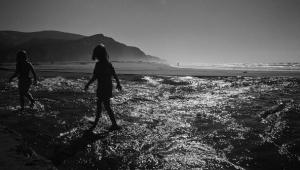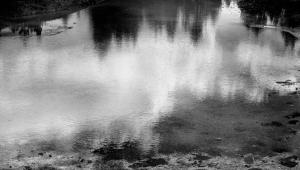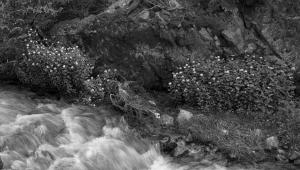Aquarium Photography: Getting Close Without Getting Wet
Even though aquariums are lit so we can see the fish and other living organisms clearly, usually the level of illumination is too dim for photography unless a large lens aperture is used and the ISO setting is high. Neither of these options is ideal, so that means flash is required. That presents a problem because of unwanted reflections in the glass (or acrylic glass).
Using Flash
There are two ways to prevent distracting reflections. First, if you are using on-camera flash, you must place the lens against the glass surface of the aquarium. This completely eliminates the reflection. To protect the aquarium as well as the lens, I recommend using a rubber lens hood. You can press the rubber hood against the side of the aquarium without worrying about scratching the glass or marring the outer rim of the lens. The picture of the sea dragon (#1) is an example of shooting with this method. There isn’t even a hint of a reflection.

All Photos © Jim Zuckerman
Second, you can use the flash off-camera. The lighting maxim, the angle of incidence equals the angle of reflectance, refers to the fact that the angle the light reflects off the glass is the same angle from which the light strikes the glass. In other words, holding the flash off to the side of the camera means the reflection on the opposite side will occur at the same angle—meaning away from the lens. Side lighting is usually more attractive than direct on-camera flash anyway, so this is my preferred method of photographing in an aquarium. The blue clam (#2) and the clown fish (#3), show the type of texture and sense of depth indicative of light coming from the side. This is why I like this kind of light so much.


Exposure
Underwater exposure is different than exposing above water. The water itself absorbs light, and in the case of an aquarium, so does the glass. If the water has some turbulence and there are a lot of particles floating in it, more light is lost. Therefore, exposure can be a challenge.
Since depth of field is vitally important when photographing small creatures—and if you are shooting a private aquarium, the fish and other animals are relatively small—you need to use a small lens aperture. The way to do this and obtain a correct exposure is to use f/22 or f/32 on the lens and set the camera to Manual Exposure mode. At the same time, use the ETTL setting on the flash (iTTL for Nikons). This should produce accurate exposures most of the time. Due to unknown factors such as light loss from the water, reflectivity of the subject (such as the albino catfish, #4), or the thickness of the glass, you may have to tweak the results. This is why it’s important to check the exposures on the LCD monitor on the back of the camera. If the pictures are not to your liking, you can adjust them in 1/3 f/stop increments using the flash exposure compensation feature on either the camera or the flash. If you don’t know where this function is on your equipment, check the instruction manual that came with both the camera and flash.

Non-Flash Photography
In large aquariums that display huge animals, such as the beluga whales in the world-class aquarium in Atlanta, Georgia (#5), flash is not the best solution. If marine mammals are close to you, the light from the flash won’t be able to disperse across the entire body of the subject. In addition, many of these animals have very light ventral areas and the light from the flash may look overexposed. Some of the animals are very sensitive to light, too, and in these exhibits there are signs asking photographers not to use flash. The octopus I photographed in the Monterey Bay aquarium (#6), is an example.


In these instances you have no choice but to raise the ISO as well as open the lens aperture. With the larger subjects like sharks and whales, depth of field is less important because they are further away, and depth of field increases as the camera-to-subject increases. I typically use the largest lens aperture available. If this still isn’t enough light to enable me to use a fast shutter speed, the strategy I use is to raise the ISO until the shutter speed is 1/125th of a second. Having said that, there are situations where the lighting is so dim that it’s just not possible to use a speed that fast. Sea nettle exhibits, for example, are magnificent because the tungsten lights provide a beautiful, ethereal type of golden light against the cobalt blue background as you can see in (#7) and (#8). Even at ISO 1000 the shutter speed may only be 1/30th or 1/60th of a second. Tripods are usually not allowed, and even if they were, the movement of the animals makes a tripod almost useless. In this situation, the higher ISO setting is required. If you used flash, the bright light would eclipse the beautiful lighting and color. Flash is a disadvantage in this case.


Lens Choice
A wise investment for shooting in low light environments is a lens with a large aperture. A 50mm f/1.4 is not expensive (as lenses go), and this is a great tool because it gathers so much light that you can use a faster shutter speed at a lower ISO. For many aquarium animals, this is perfect. More expensive options are 85mm f/1.2 and the 200mm f/2. Both of these lenses are better for photographing underwater subjects that are a few feet away. When shooting small fish, coral, clams, etc., I opt for the 50mm lens.
Sometimes a zoom is more advantageous because as fish swim past you, their distance to the lens changes. Having the ability to vary the composition in the way you crop the shot by changing the focal length is very handy. I use a 24–105mm all the time for photography in an aquarium, but the price I have to pay is a smaller maximum lens aperture.
Maximum Sharpness
Aquarium glass is thick, and this has a direct bearing on the quality of the images. For maximum sharpness, the lens axis must be perpendicular to the surface of the aquarium glass. As soon as the camera is angled even slightly, the image quality spirals downward very quickly.
Therefore, as a fish swims past the camera, don’t follow it by panning as you normally do. Instead, you have to physically move with the fish so the lens is always shooting at a 90˚ angle.
- Log in or register to post comments












































